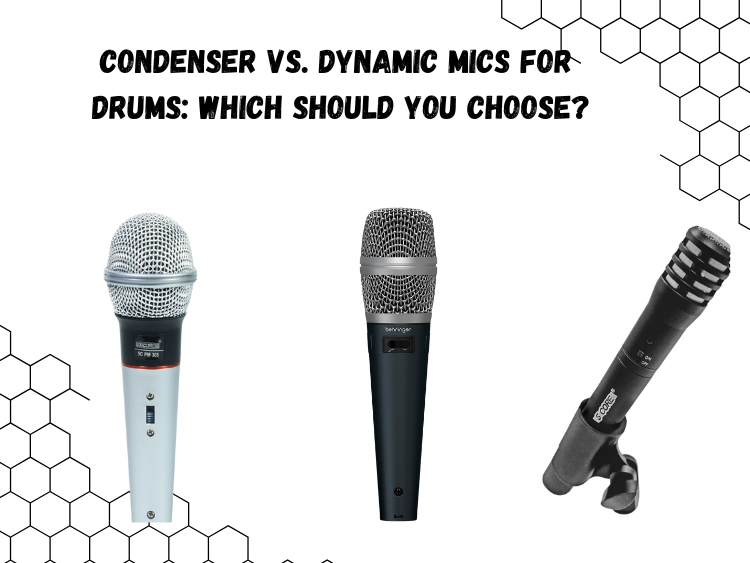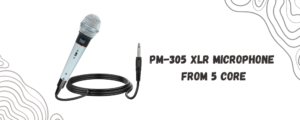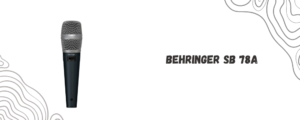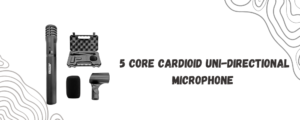When it comes to drum recording mics, one of the most debated topics in any studio setup is condenser vs dynamic mics. Each type of microphone brings something different to the table—and when you’re working with an instrument as complex and aggressive as a drum kit, choosing the right mic can seriously impact your overall sound.
So, which is better for miking drums: condenser or dynamic? Let’s break it down in plain English—no fluff, just facts, use-cases, and real product examples.
The Role of Microphones in Drum Recording
Recording drums is not like recording vocals or acoustic guitars. Drums are loud, fast, and have a wide frequency range—from the low-end punch of a kick drum to the bright attack of cymbals. That’s why drum mic selection is a strategic move, not just a plug-and-play decision.
There are two main mic types that dominate drum recordings: dynamic microphones and condenser microphones. Here’s what sets them apart—and how that affects your drum tone.
Dynamic Mics: Built for Impact
Dynamic microphones are built for toughness. They handle high sound pressure levels (SPL) without breaking a sweat, which makes them the default choice for kick drums, snares, and toms. Their limited sensitivity and narrow frequency response actually work to your advantage when you’re trying to isolate sound sources and reduce bleed in a tight mix.
They don’t require phantom power, making them easier to use in live situations or portable setups. A cardioid dynamic like the PM-305 XLR Microphone from 5 Core is a good example of a mic that handles loud snare hits without distortion and still retains decent tone.
In live settings especially, durability and simplicity often take precedence over detail. You’ll find dynamic mics clipped to toms and snares across stages worldwide, just doing their job without fuss.
Condenser Microphones: Detail and Dimension
On the other hand, condenser microphones are all about capturing detail. These mics are more sensitive and have a wider frequency response. This makes them perfect for cymbals, overheads, and room miking—anywhere you want that full, crisp capture of highs and ambient nuances.
Of course, they require phantom power and tend to be more fragile than their dynamic counterparts. But in a controlled studio environment, a good condenser makes all the difference. A model like the Behringer SB 78A excels at bringing out the airiness of hi-hats or the depth of a stereo overhead image.
Likewise, an instrument condenser mic such as the 5 Core Cardioid Uni-Directional Microphone works well in both live and studio environments where clarity is essential. It captures cymbal decay with finesse while still rejecting unwanted bleed.
Interestingly, 5 Core even provides great discounts to business owners if you’re buying in bulk. Refer to this site for more information. Here’s also a one-stop platform where you can find all their products.
So, What’s the Real Difference?
Let’s break it down to the fundamentals:
| Feature | Dynamic Mics | Condenser Mics |
| Sensitivity | Low | High |
| Frequency Range | Narrow | Wide |
| SPL Handling | Excellent | Good to Great |
| Power Requirement | None | Phantom Power |
| Use Cases | Kick, Snare, Toms | Overheads, Cymbals, Room Mics |
If you’re miking a kick or a snare, a dynamic mic offers controlled output that’s easy to mix. For overheads or detailed room capture, condensers are far more suited due to their sensitivity and broader frequency response.
Can You Use One Type for Everything?
Technically, yes—but should you? Not really.
You could try to mic your whole kit with dynamic mics. It’ll give you a tight and focused sound, but you’ll lose cymbal brilliance and room character. The sound may end up dull or boxy, especially in a studio recording.
On the flip side, using all condenser mics might offer detail, but bleed becomes a serious issue. Plus, not all condensers can handle the sheer impact of a close-miked kick or snare. That’s where distortion and clipping enter the picture, and once they’re in the recording, there’s no fixing it in post.
If you’re experimenting with an all-condenser setup, you might want to dial in your gain structure carefully. Even a cardioid condenser like the 5 Core Uni-Directional Mic can behave very differently depending on mic distance and placement.
Final Thoughts
There’s a reason professional studios don’t pick a side in the condenser vs dynamic mics debate when it comes to drums—they use both. And that’s not about indecision. It’s about capturing the full sonic range of the drum kit effectively.
Dynamic mics give you control, focus, and resilience. Condensers give you detail, space, and natural brightness. The best drum recordings come from a hybrid approach—kick and snare on dynamics, overheads and rooms on condensers.
Even in live settings, a mix of both mic types can improve the front-of-house sound dramatically. You can tame the aggressive midrange with dynamics while letting condensers fill in the sonic gaps overhead.
So don’t choose one over the other. Let the drum kit decide.




